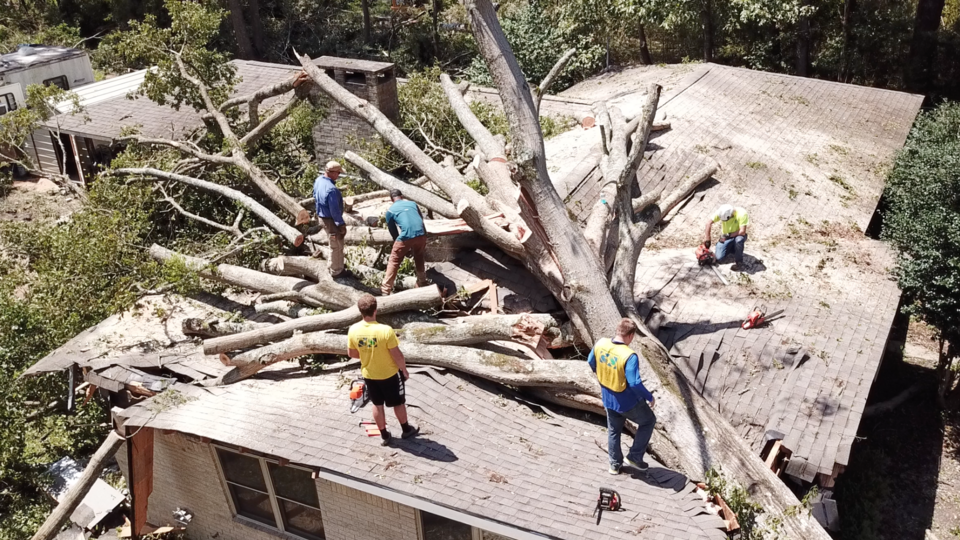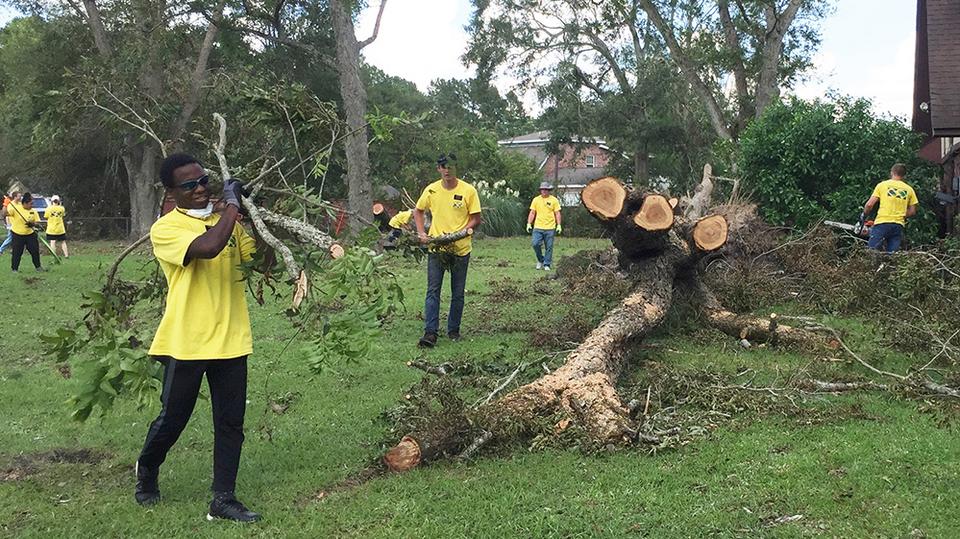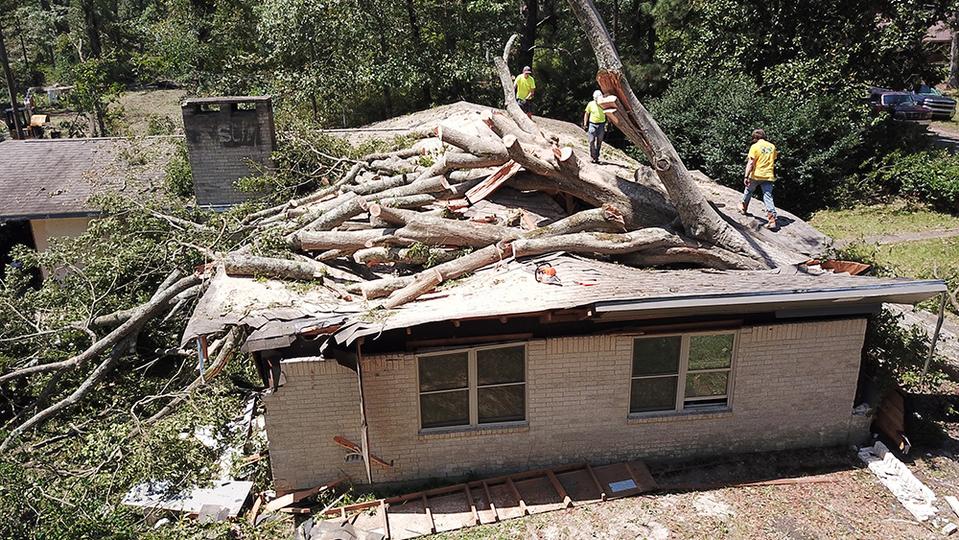
Hurricane Laura
A Helping Hands crew of heavy equipment operators and chainsaw experts from Jackson, Mississippi, helps Larry Catron remove trees from his house and backyard in Leesville, Louisiana, after Hurricane Laura pounded the Texas-Louisiana border on August 27 with torrential rain and wind speeds of 150 mph.2020 by Intellectual Reserve, Inc. All rights reserved.This story appears here courtesy of TheChurchNews.com. It is not for use by other media.
By Aubrey Eyre and Sydney Walker, Church News
Organized efforts are underway in Louisiana and Texas to begin assessing damages for cleanup and repair following Hurricane Laura, which struck the Gulf Coast early Thursday, August 27.
The Category 4 hurricane — with a top wind speed of 150 mph and one of the strongest to ever strike the U.S. — has left a trail of destruction and almost 900,000 homes and businesses without power, according to the Associated Press. At least six people are dead.
Richard Long, the welfare and self-reliance manager for the Church’s North America Southeast Area, who is helping coordinate relief efforts between Church headquarters and the local stakes affected in Louisiana, said Friday, “There’s a lot of information still coming back to us, so we’re just now getting in to do assessments.”
Long noted that many of the most heavily rain- and flood-damaged areas — most of which are near Lake Charles and Cameron, Louisiana — are not yet accessible.
“This weekend there may be opportunities to get into those wet areas, but next weekend is when we’ll be able to help more,” he said. “The primary focus this weekend is to supply 400 to 500 volunteers from outlying stakes to help as people begin to return from their evacuation sites.”
Long said he expects next weekend’s continued efforts will require more inventory and volunteers to assist clean-up efforts in the area.
.
Damage Reports
Lisa Leavitt, the welfare and self-reliance manager for the Church’s North America Southwest Area, explained that Hurricane Laura passed over most of the Southwest area, affecting only a small portion of Texas with wind damage and the southwestern-most part of Louisiana, which falls in that area’s borders.
The hardest-hit area — near Lake Charles, Louisiana — is still inaccessible for residents, she noted. Although members and residents of the Beaumont Texas Stake were able to return to their homes to begin assessing damages yesterday, communities in the Orange Texas Stake — including two wards in Lake Charles — are still awaiting the green light to safely return to their homes.
Elder Paul B. Pieper, a General Authority Seventy and president of the North America Southwest Area, provided an update on Friday morning, compiled by local leaders the evening before.
“One female member in Lake Charles is missing,” the report stated. “Several members in Lake Charles will be displaced.”
Five members’ homes in Lake Charles were destroyed, and several other members’ homes sustained roof damage. The roof of the meetinghouse in Lake Charles was ripped off.
Local leaders anticipate additional homes in Lake Charles were damaged, but they are unable to verify the total number until residents are allowed to return. Interstate 10 remains closed at the Texas-Louisiana border. Because the hardest hit areas are not accessible, clean-up efforts in Lake Charles will likely not happen this weekend.
One member’s home in the Beaumont Texas Stake received significant damage, while five other members sustained minor damage to their homes, according to the report. A few members in the Shreveport Louisiana Stake also reported minor damage to their homes.
A similar early assessment report from Elder James B. Martino, North America Southeast Area president, noted damage to some members’ homes in the Alexandria Louisiana Stake and Monroe Louisiana Stake. There is minor damage to some meetinghouses but no damage to the Baton Rouge Louisiana Temple.

Hurricane Laura
Helping Hands volunteers help clear downed trees and debris from a home in Leesville, Louisiana, after Hurricane Laura pounded the Texas-Louisiana border on August 27 with torrential rain and wind speeds of 150 mph.2020 by Intellectual Reserve, Inc. All rights reserved.Organizing Relief Efforts
The majority of stakes in the Gulf Coast areas undergo regular trainings to ensure they are prepared for emergency response plans in the event of hurricanes or other natural disasters, Long explained. “We have whole extensive training programs that prepare stakes to run command centers and act as staging areas for supplies,” he said.
There is also a great deal of collaboration at local and national levels. Partnerships with other disaster responders like FEMA ensure that information regarding needs of people affected by the storm are communicated in an organized manner and that supplies can be sent where they are most needed, Long said. “We’re working in unison with the other organizations and we have good relationships with them.”
Explaining how relief efforts are organized, Long said, “We all use the same crisis response software program and when we set up a command center, we establish a call center and publish a telephone number so that community members can call for help and relay information about damage,” he said.
Once the reports are in, volunteers and supplies are organized and sent out to meet the community needs. And if volunteers encounter more problems in the field, they report those when they return so that everything is tracked and documented, he said.
When word of a potential storm comes, the stake and area leaders mobilize to ensure that local storehouses are stocked with inventory to handle the immediate needs of coming disasters, and requests for more supplies can often be made in advance of the storms.
Long noted that an order for a truck with additional supplies from Church headquarters in Salt Lake City was put in days ago, and the truckload should be arriving in Leesville, Louisiana, just in time for the weekend’s response efforts.
Evacuation plans for stakes in the areas, planned well in advance, were executed days before the storm hit land; as such, the numbers of members affected by the storm have been low, Long said. There was also no need this time to make use of Church buildings as evacuation sites, he added.
15 Years Since Hurricane Katrina
Although Hurricane Laura made landfall days before the 15th anniversary of Hurricane Katrina, Long said he believes many members feel blessed this time around.
“I think the remarkable part of this was that [Tropical Storm] Marco (which made landfall three days before Laura) was tempered. Had it hit with its furry and then had Laura come through right after, it would have ripped this place to pieces,” he said.
With Marco and Laura both as fast-moving storm systems, there was less time than expected to prepare for the disaster and carry out evacuation orders, Long said. However, the tempering of the first storm and people’s reactions and preparations help mitigate the damage.
“Laura didn’t cause the damage we expected,” he said. “It wasn’t what we anticipated, and I think people really paid attention because they remember the severity and still have memories of Katrina, and so they took this very seriously as a result.”
Long added, “The Lord tempered this storm.”

Hurricane Laura
A Helping Hands crew of heavy equipment operators and chainsaw experts from Jackson, Mississippi, helps Larry Catron remove trees from his house and backyard in Leesville, Louisiana, after Hurricane Laura pounded the Texas-Louisiana border on August 27 with torrential rain and wind speeds of 150 mph.© 2020 by Intellectual Reserve, Inc. All rights reserved.Text Copyright 2020 Deseret News Publishing Company